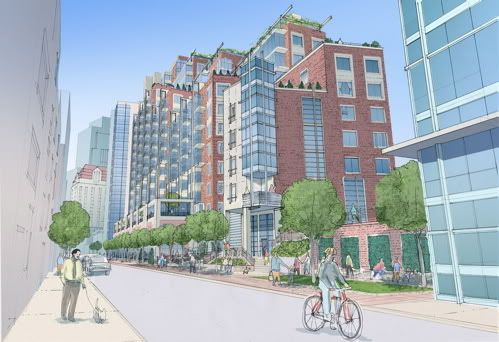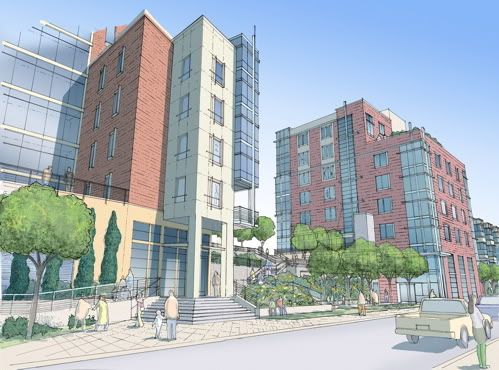After Two Years, Hudson St. Land Deal Nearing Finish Line
Jul 20, 2007
by Adam Smith
After nearly two years of negotiating with state officials, the development team planning to build a housing tower on Hudson Street ? in the same spot where hundreds of Chinatown residents were forced to leave over 50 years ago ? says an agreement to buy the property is nearly completed.
The Asian Community Development Corporation has teamed with lead developer New Boston Development Partners to build more than 300 apartments and condominiums on property known in Chinatown as Parcel 24. They said recently that a 99-year lease agreement and development agreement with the Massachusetts Turnpike Authority could close as early as the end of August.
?The end is really near,? said the Asian CDC?s director of housing, Katherine Oh Roof, referring to the deal with the Turnpike Authority. Oh Roof, as well as the group?s director, Jeremy Liu, declined to discuss the price of the land before the deal is closed, but they both said the amount would be ?nominal.? For several years after Parcel 24 became available for development, community groups, including the Asian CDC, lobbied for a low-cost sale of the land, saying that because it was taken from Chinatown residents in the 1950s and 1960s for highway use, it should be sold for only $1.
A spokesperson for the Turnpike Authority confirmed the negotiations on the lease agreement and development plan were likely nearing completion, but would not comment on the price of the property.
Oh Roof cautioned that securing the land could be somewhat complicated because about a quarter of Parcel 24 is owned by the Massachusetts Highway Department.
?There are still a lot of murky legal issues to deal with,? she said during a Chinatown meeting in July.
In addition, she said, once the contract with the Turnpike Authority is completed, the soil conditions will need to be tested, and then the city development review can begin.
?This process is still very much in the beginning,? she said.
She anticipated that construction, which could take two years to finish, would not start until 2009.
Oh Roof estimates the project will cost $127 million, and the Asian CDC and New Boston Development hope to acquire about $23 million in public funding, including tax credits.
On July 19, when Sampan went to press, the Boston Redevelopment Authority?s board was slated to decide whether it would direct $1.8 million in affordable housing funds to the Asian CDC for the Parcel 24 project.
The mixed-income building, which would be about 20 stories at its highest point, would include 70 apartment units and up to 99 condo units priced according to the city?s affordable-housing limits or below and up to 189 market-rate condos.
Link
Jul 20, 2007
by Adam Smith
After nearly two years of negotiating with state officials, the development team planning to build a housing tower on Hudson Street ? in the same spot where hundreds of Chinatown residents were forced to leave over 50 years ago ? says an agreement to buy the property is nearly completed.
The Asian Community Development Corporation has teamed with lead developer New Boston Development Partners to build more than 300 apartments and condominiums on property known in Chinatown as Parcel 24. They said recently that a 99-year lease agreement and development agreement with the Massachusetts Turnpike Authority could close as early as the end of August.
?The end is really near,? said the Asian CDC?s director of housing, Katherine Oh Roof, referring to the deal with the Turnpike Authority. Oh Roof, as well as the group?s director, Jeremy Liu, declined to discuss the price of the land before the deal is closed, but they both said the amount would be ?nominal.? For several years after Parcel 24 became available for development, community groups, including the Asian CDC, lobbied for a low-cost sale of the land, saying that because it was taken from Chinatown residents in the 1950s and 1960s for highway use, it should be sold for only $1.
A spokesperson for the Turnpike Authority confirmed the negotiations on the lease agreement and development plan were likely nearing completion, but would not comment on the price of the property.
Oh Roof cautioned that securing the land could be somewhat complicated because about a quarter of Parcel 24 is owned by the Massachusetts Highway Department.
?There are still a lot of murky legal issues to deal with,? she said during a Chinatown meeting in July.
In addition, she said, once the contract with the Turnpike Authority is completed, the soil conditions will need to be tested, and then the city development review can begin.
?This process is still very much in the beginning,? she said.
She anticipated that construction, which could take two years to finish, would not start until 2009.
Oh Roof estimates the project will cost $127 million, and the Asian CDC and New Boston Development hope to acquire about $23 million in public funding, including tax credits.
On July 19, when Sampan went to press, the Boston Redevelopment Authority?s board was slated to decide whether it would direct $1.8 million in affordable housing funds to the Asian CDC for the Parcel 24 project.
The mixed-income building, which would be about 20 stories at its highest point, would include 70 apartment units and up to 99 condo units priced according to the city?s affordable-housing limits or below and up to 189 market-rate condos.
Link
Last edited:




